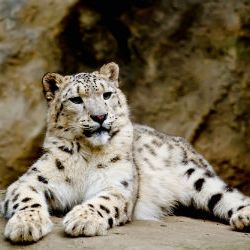Snow Leopard Tourism

Snow leopards are elusive. They live high up in the mountains of central Asia. They inhabit rugged, inaccessible terrain. Estimating their numbers is difficult but the Snow Leopard Trust believes there are between 3500 to 7000 snow leopards in the wild. The cold mountainous climate and harsh surroundings make sightings rare. Tourism to view these beautiful creatures would seem unlikely but that is what is emerging in an effort to help protect them.
Threats
Snow leopards are listed as vulnerable because they number fewer than 10,000. There are a several issues that threaten their existence.
- Mining devastates their habitat, and brings with it people and infrastructure.
- Climate change means rising temperatures are reducing their habitat. The lower altitude tree line is slowly shifting up the mountains and domestic animals are grazed higher. The shrinking habitat also threatens the existence of the snow leopards natural prey such as ibex and blue sheep.
- As domestic animals replace the wild ones within their habitat the leopards hunt them instead (i.e. yak, sheep, goats and even horses) which causes friction with the local village herders. Up to 450 leopards are thought to be killed per year mostly by herders. Some are killed by poachers for skins.
Innovative Conservation
Snow leopards are seen as a threat to livestock by villagers living in the mountain regions. However, innovative conservation programs and snow leopard tourism has started to change their attitude.
A good example is in the village of Kibber in the Spiti Valley in Northern India. The locals, assisted by conservation workers, had a pioneering approach to the threat posed by snow leopards. They set aside pasture for wild animals such as ibex and wild blue sheep so that their numbers could grow. That provided further prey for the snow leopards and meant they were less likely to attack the villagers livestock. This in turn meant the leopards are less likely to be killed by the village herders.
An insurance policy was also introduced. There was slow uptake to begin with. Willing participants paid roughly $5 a year to insure against livestock being killed by snow leopards. At the end of first year 4 herders were paid for livestock that was killed. Payment was made in front of whole village, and soon after all herders within the village signed up to the insurance scheme. The scheme was supported by Indian Nature Conservation Foundation (NCF) and The Snow Leopard Trust and has since spread to many other villages. This, in addition to making sure the leopards have wild prey, serves to reduce the retaliation by herders for leopards killing livestock.
Tourism
The efforts in Kibber led to more snow leopard sightings. That paved the way for ‘snow leopard’ tourists. The first tourists came in 2015. Last year 200 tourists came, spending approximately $100k in the village. The locals now see the leopards as a source of income rather than a threat.
While this is a conservation success story, the threats to snow leopards are still existent elsewhere. Poaching, mining, reduction in prey and retaliation from herders needs addressing across the whole central Asia mountain regions if this beautiful and elusive creature is to move beyond vulnerable status.
If you would like to find out more about protecting Snow Leopards please visit our Adopt a Snow Leopard page.



